Companies need to harness the power of social media community influencers — the new healthcare decision makers.
Social media provides a huge opportunity for pharma companies to engage with patient leaders and connect to their larger community audiences. Working with advocates and influencers not only yields pertinent insights about what consumers want and need, but engaging with advocates can help engender trust in the company and brand. Further, according to Marketing Hub, influencer marketing is the No. 1 fastest online customer-acquisition method.
“With trust as the fulcrum upon which influencer marketing campaigns succeed, it should be of little surprise that marketers in the pharmaceutical industry want in," says David Goldsmith, chief strategy officer, WEGO Health.
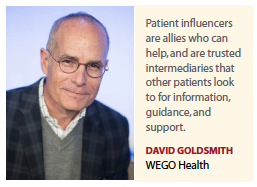 And since influencer marketing has shown to increase engagement with patients, it’s a win-win for pharma companies. “Patient influencers are trusted intermediaries who other patients look to for information, guidance, and support," he says.
And since influencer marketing has shown to increase engagement with patients, it’s a win-win for pharma companies. “Patient influencers are trusted intermediaries who other patients look to for information, guidance, and support," he says.
For example, a major pharmaceutical company asked patient influencers with a rare disease to encourage their peers to download a resource kit designed to help them better track and manage their symptoms. The 90-day campaign targeted women in underserved, minority communities, who can be difficult to reach through traditional channels. The company hired patient influencers to create educational videos that could be shared on Facebook and Instagram. The campaign drove 1.6 million impressions and more than 240,000 views of patient videos. In the end, from an engagement perspective, the company reported results that were three times better than other channels it had previously used to connect with this patient population.
“As social media has become a trusted source, social media influencers have grown in credibility," says Steven Closter, VP, marketing, Sunovion Pharmaceuticals.
He suggests that pharma companies need to listen to online communities to understand their needs, desires, and motivations, as well as to discover who is seeking advice or offering solutions and where conversations take place. Armed with that potential for a wealth of actionable data and tangible insights, marketers next need to determine where the brand can add value to discussions, and then build relationships with influencers who represent communities.
“Whether it is our Be Vocal: Speak Up for Mental Health partnership, which spotlights people living with mental health conditions and creates connections and empowers others to speak 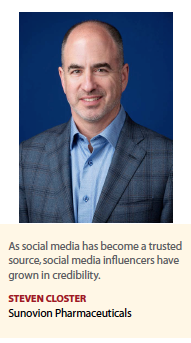 up, or Little Big Things where a networked community shares innovations that could have a big impact for people living with Parkinson’s disease, we acknowledge that people want to speak with those who empathize and understand," Mr. Closter says.
up, or Little Big Things where a networked community shares innovations that could have a big impact for people living with Parkinson’s disease, we acknowledge that people want to speak with those who empathize and understand," Mr. Closter says.
Ron Lacy, VP, products and innovation at UBC, says social media is transforming the expectations that patients have of drug manufacturers. “Leading organizations are participating and fostering disease state support groups inside platforms such as Facebook where patients and caregivers are hearing from leading advocates in the market," he says.
“These advocates help in more ways than just being key opinion leaders, they are caregivers who have struggled with helping their loved ones start and stay on therapy and overcome all of the barriers associated with the particular disease state. Biopharmaceutical companies must be careful to not only monitor what is being shared on the site, but be transparent and forthright on what patients can expect from them."
As consumers become more empowered to understand the choices that are available to them in healthcare, influencers become more important. Although influencers get compensated for their work with pharma companies, most are organically altruistic in that they are living with a disease and care about other patients who are like themselves.
“While the influencers can be compensated to amplify a message, they typically feel a responsibility to their followers to make recommendations of products and services that they truly believe in," says Paul Golota, CEO at MedSurvey. “Because healthcare influencers tend to be people who have been affected by the medical condition they advocate for, they typically have earned the trust of their community and followers."
In a world of endless choices, listening to someone you trust can make the difference when making a decision. Therefore, companies need to engage influencers as part of their strategies when considering the promotion of their services and products. While paid influencer campaigns work, they work best when the influencer has completely bought into the product or service they are promoting to their community.
“One key industry challenge is enabling influencers to maintain their authentic voices, as we work with regulatory authorities to advance dialogue related to medical conditions, treatments, and solutions," Mr. Closter says. “Social communities can help validate medical 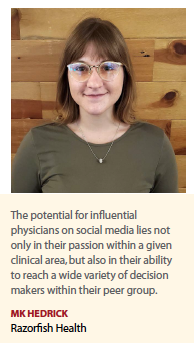 needs. We need to find more ways to partner authentically and compliantly."
needs. We need to find more ways to partner authentically and compliantly."
It is important that companies harness the power of influencers and advocates by viewing them as people first, not just patients, says Olivier Chateau, co-founder and CEO, Health Union. When the person is prioritized, understanding where the treatment fits becomes more natural. “Instead of thinking of patients as promotional outlets, companies need to embrace the sensitivities and nuances that impact the patient journey," he says. “Approaching patient advocates from this mindset will help shape the influencer relationship as one that benefits people living with the condition first, not just how to best market a company’s treatment."
For companies to understand the true impact patient advocates can have, they need to engage, integrate, and gather advocates’ perspectives as early as possible in the research and discovery process, including the target product profiles and clinical trial development phases. Many of these advocates are ready and willing to share their physical and emotional journeys. For example, Mr. Chateau says, a patient advocate posted a poem on Migraine.com about her physical and emotional journey as she participated in clinical trials for the calcitonin gene-related peptide (CGRP) therapies before they were FDA-approved for people living with migraine. The poem read: This drug, in all its forms, May be the miracle, We’ve been waiting for, Not, of course, a cure, But the closest any of us, Has ever seen.
“Perspectives like this are extremely valuable to understand visceral, unmet needs, and companies would be wise to seek them out," he says.
Earlier this year, WEGO Health polled patient influencers to see how and why they use social media (see sidebar). They surveyed 412 influencers across hundreds of conditions, and published the quarterly report “Patient Influencer Perspectives on Social Media. The report found that pharma companies lag behind other health-related organizations when it comes to connecting directly with patient influencers through social media. For example, 92% of patient influencers follow a health advocacy organization and 48% follow a healthcare provider such as a doctor, clinic, or hospital. By contrast, only three out of 10 follow a pharma brand. Similarly, 66% of influencers subscribe to one or more channels on YouTube, but fewer than 10% subscribe to a channel sponsored by a pharma brand.
“Social media and its influencers remain one of the most underutilized channels in healthcare marketing," says Carolyn 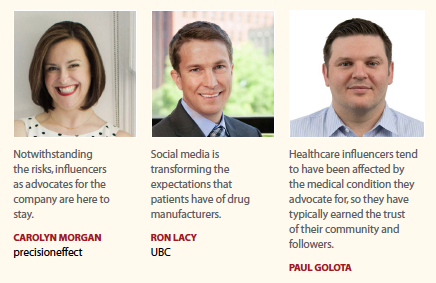 Morgan, president of precisioneffect. “The core reason for this is obvious: the strict regulations associated with promoting healthcare brands."
Morgan, president of precisioneffect. “The core reason for this is obvious: the strict regulations associated with promoting healthcare brands."
Ms. Morgan says despite the countless nightmare stories associated with influencers going off script and/or promoting brands in an unregulated or off-label way, there is a large opportunity that, if done correctly, can ensure both compliance and results. “I have three quick tips to keep in mind," she say. “First, keep it to disease state. There is so much opportunity to educate audiences, and the emotional and intellectual storytelling for disease education can be clear, powerful, and much more motivating than most brand marketing allows. Second, keep it simple. Do not overcomplicate the ask of the influencer; give them the information they need in quick, approved soundbites and content — video, graphic, etc. — so that they can massage and deliver it in their medium in a way that is authentic to them.
Third, keep it quick. What are we asking the consumer to do? Sign up for an action? Talk to a doctor? Request a genetic test? Ask one thing of your audience and then help them feel rewarded for it by showing them number of tests requested, patients diagnosed, etc. 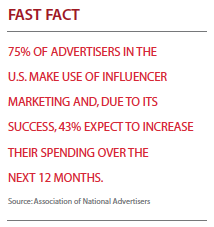 Gone are the days of brands needing to own both awareness and conversion. Today, disease state education can own awareness and brands can own a conversion"
Gone are the days of brands needing to own both awareness and conversion. Today, disease state education can own awareness and brands can own a conversion"
Speaking from a regulatory perspective, Jeremy Lutsky, counsel, Manatt, Phelps & Phillips, says companies need to be aware of the risks of being compliant on social media and the importance of training influencers.
Companies using social media to reach providers and patients to get patients to enroll in clinical trials and to drive product prescriptions need to review their sites and blogs and closely monitor content and limit certain posts and correct misinformation. Companies need to make sure that similar to print and television advertising, these hosted sites include “fair balance" of both the efficacy of products, as well as the safety data, risks, potential adverse events, and links to the full label. It is important that companies closely train their influencers and monitor what they say about the products. These individuals are paid representatives of the company and any missteps or misinformation provided by them leads to company liability. In addition, companies must be transparent in disclosing that the influencers are connected to the company and paid for their activities.
Physicians also can be reached through online influencers, says MK Hedrick, manager, data and analytics, Razorfish Health. “The most influential physician voices on social media are not always the traditional KOLs that healthcare companies have historically partnered with," she says. “While traditional KOL partnership is still necessary to gauge the opinions of the most established members within a clinical community, healthcare companies can and should be partnering with influential physicians on social media to capture the beliefs and practices of the broader specialty community."
The partnership potential for influential physicians on social media lies not only in their passion within a given clinical area, but also in their ability to reach a wide variety of decision makers within their peer group. Recently, a prominent cardiologist influencer on social media posted a short video of an echocardiogram using hashtags popular with the online cardiology community. Ms. Hedrick says the resulting comments on the video from cardiologists and cardiac care nurses sparked many valuable discussions, such as the nature of rare disease presentation, the difficulties of cardiac imaging, and suggestions of tests to perform to proceed with a treatment plan.
“When discussing physician partnership opportunities with our healthcare clients, we recognize that physicians on social media are not just influencers, but authentic community members themselves," Ms. Hedrick says. “They know the right platforms and community hashtags to engage their colleagues, and they have existing social relationships with other members of their specialty audience." (PV)
~~~~~~~~~~~~~~~~~~~~~~~~~
Patient Influencer Perspectives
Findings from WEGO Health’s Social Media Report
Earlier this year, WEGO Health polled patient influencers to see how and why they use social media and issued its Patient Influencer Perspectives on Social Media report. Three important findings include:
Facebook is the primary social media used by patient influencers. Despite concerns with Facebook’s security measures and business practices, nearly all (98%) patient influencers continue to use Facebook, and nine in 10 say they use it daily; 94% of influencers are members of a health-related Facebook group.
Pharma needs to find a way to connect with influencers. The primary value of social media is the ability to connect with other patients, but they also want to access health information and find support. Nine in 10 patient influencers follow an advocacy organization and nearly half follow a healthcare provider. While many pharma companies have a social media presence, only one in five influencers follow a pharma company, with slightly more following a brand if they are on that specific therapy. They might not be engaging directly, but patients are certainly using social to talk about pharma. Nearly seven in 10 patient influencers have shared both positive and negative medication experiences.
Social works for informing patients. According to WEGO Health, 87% of patients will ask their physician about a medication if they learned about it from a trusted patient influencer. Nine in 10 patient influencers say online communities play at least a “somewhat important" role in their health decisions, with nearly half (48%) saying that online communities play a “very important" or “extremely important" role.


















